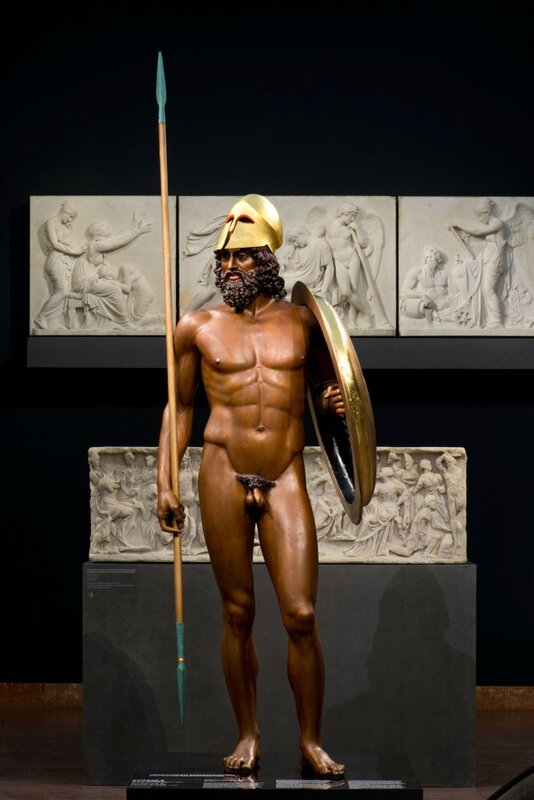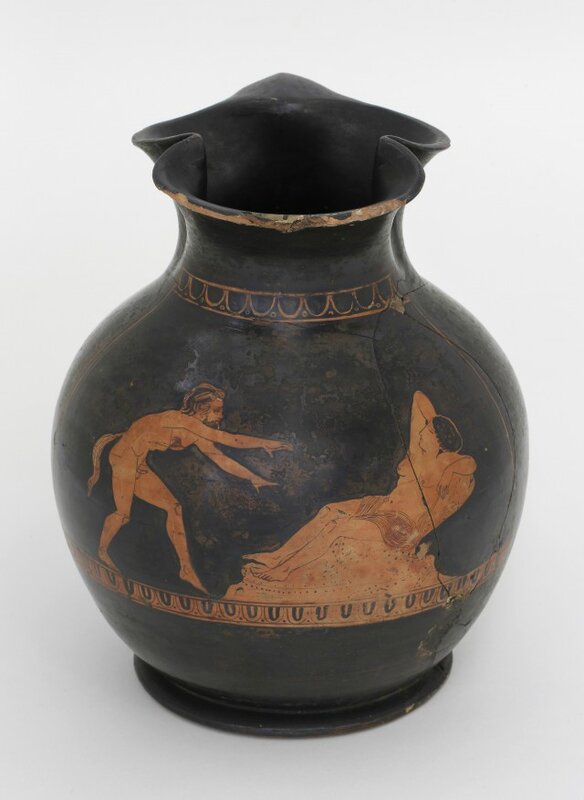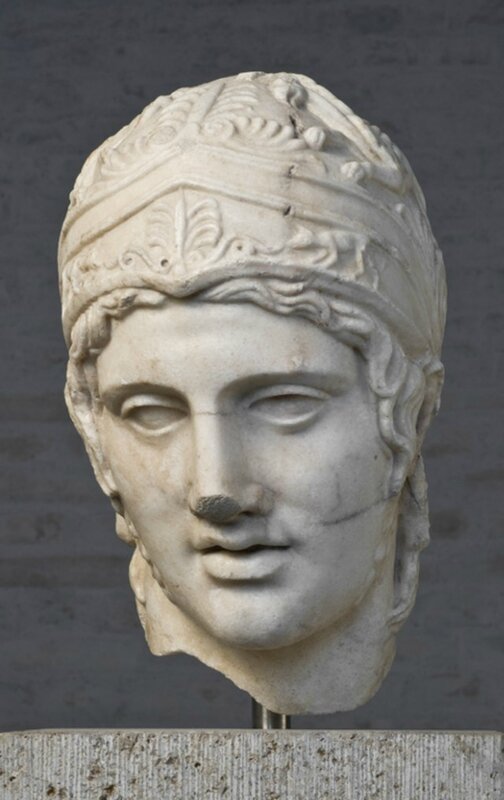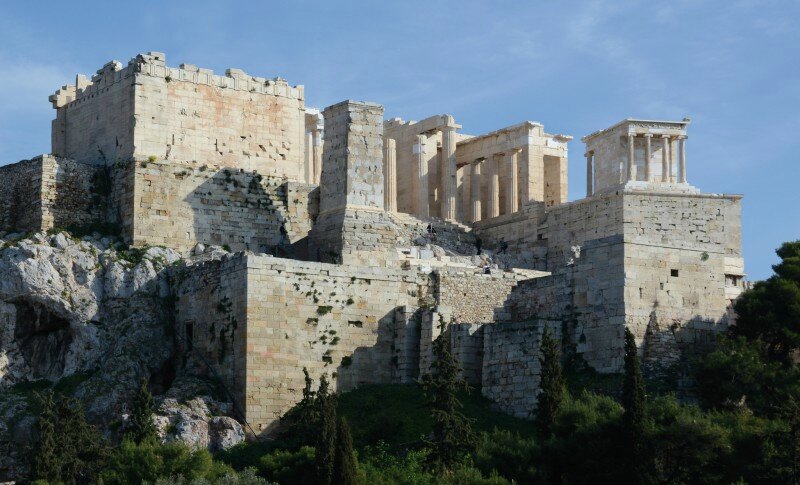Exhibition at Liebieghaus Skulpturensammlung recounts the myth of Athens
FRANKFURT.- The extensive special exhibition “Athens: The Triumph of Imagery”, taking place at the Liebieghaus Skulpturensammlung from 4 May to 4 September 2016, is being devoted to the powerful pictorial world of classical Athens and provides vivid insights into its rites, sacrifices, processions and festivals. With the aid of more than one hundred prominent loans from major collections of the world ‒ among them the British Museum, the Louvre and the Vatican Museums ‒ the show recounts the myth of Athens, its goddess Athena and her son Erechtheus. It is a story of love, longing, violence, death and reconciliation. The lives of Erechtheus and his virgin mother were solemnly celebrated with the great festivals that dictated the cycle of the Attic year. The calendar year began, for example, with the celebration of the birth of the son and new king, and ended with the feast observing his sacrificial death.
In a concentrated scenographic staging, the exhibition “Athens: The Triumph of Imagery” explores the twelve months of the Attic calendar. The myriad objects displayed will allow visitors literally to experience, with all their senses, the ancient festivals and their direct relationship to the myth of Athens. The myth not only inscribed itself in the Athenian rites and processions: the show also provides a multifarious impression of how the thrilling tale of Athena is mirrored in the city’s monuments ‒ the sculptures decorating the marble edifices, but also the individual statuary dedications. The exhibition concludes with a look at the two historical planners of this newly created visual programme – the cultural politician Pericles and his general artistic director Phidias, who shaped the image of classical Greece by which we still know it today. It was under their supervision that the splendid reconstruction of the city and its sanctuaries was realized following their destruction by the Persians in 480 and 479 BC.
“The show focuses on Athens in the Golden Age of Pericles. No other epoch contributed as much to shaping our conception of classicism as the era of Athens’s reconstruction after the victory over the Persians. At the Liebieghaus Skulpturensammlung, the multifaceted world of Attic imagery that emerged at that time will be brought back to life by an entirely new approach to the reception of antiquity”, explains Max Hollein, the director of the Liebieghaus Skulpturensammlung.
Marble statue of a daughter of Erechtheus (?) from the caryatid porch of the Erechtheion (Kore C, so-called “Caryatid”) From the Athenian Acropolis. Modern plaster castafter the original in British Museum. Marble, ca 410 BC. Archäologisches Institut der Universität Göttingen. Photo Stephan Eckardt
“We are especially delighted about the fact that, following many years of in-depth research, it has been possible to develop a more precise – and also a better understandable – conception of the city of Athens. We are moreover extremely grateful for the many extraordinarily prominent loans. The Frankfurt exhibition will convey the captivating tale of Athena and her enmity towards Poseidon in particularly impressive manner ‒ with the aid of antique artworks but also by way of a specially developed media presentation”, comments exhibition curator Vinzenz Brinkmann.
Gorgoneion. Roman marcle copy, possible of the shield device of the gold and ivory statue of Athenia Parthenos by Phidias, so called "Medusa Rondanini", modern plaster cast after original in Munich Glyptothek, around 120-130 AD. Plaster, height: 39 cm. Archäologisches Institut der Universität Göttingen. Photo Stephan Eckardt
Whereas many people of our time are familiar with the events surrounding the battle over Troy, the present-day public often lacks fundamental knowledge about the great city goddess Athena and the “fairy tales” of Attica, the most important cultural landscape of antiquity: of central importance in this context is the story of Athena herself and her son Erechtheus. The myth that determined the annual cycle in classical Athens recounts the goddess’s life. It begins with her birth from the head of Zeus, followed by her rivalry with Poseidon over supremacy in Attica, the story of the erotic relationship between the virgin goddess Athena and Hephaistos, the god of blacksmiths, the resulting conception of Erechtheus, his birth, youth, marriage and fatherhood, the war with Poseidon, Erechtheus’s sacrificial death for the well-being of his people, and finally his “resurrection” as an immortal serpent and the reconciliation with the Olympians.
In twelve rooms, the Frankfurt exhibition “Athens: The Triumph of Imagery” outlines the twelve-month Attic calendar, thus bringing the rites, processions and festivities of the annual cycle to life. Each room focuses on a different feast, which in most cases gave the respective month its name. Plaster casts of sections of the 160-metre-long Athenian Parthenon frieze (440 BC) – which, according to recent research results, illustrates the wide range of festivals making up the annual Attic cycle – provide vivid impressions of each month’s celebrations. The images on a number of very special Greek vases from the collections of the British Museum in London, the Kunsthistorisches Museum in Vienna, the Antikensammlung in Berlin and elsewhere explain the feasts and ceremonies. They depict everything from preparations for weddings to sacrifices at graves. Quotations from classical literature further enhance the pictorial descriptions of the important festivals. In the ‘month rooms’, famous sculptures dating from 450 to ca. 410 BC, the high classical period, refer to the temples that served as ceremonial sites and thus forge a link to the myth. With the aid of context panoramas consisting of graphics as well as still and moving images, the exhibition conveys a vibrant impression of the rites and festivities of the period in question. The elaborate graphic staging was developed by the prestigious Atelier Markgraph in close coordination with the Liebieghaus team.
The first room in the exhibition features the Hekatombaion, the first month of the Attic calendar. It was in this month that Athens’s most important feast was celebrated the Panathenaia in honour of the birth of Erechtheus. The visitors will encounter him and his mother in various manifestations, including the marble statue Athena with Her Child in a Basket (ca. 410 BC (?), Musée du Louvre, Paris). This work shows the goddess with a little basket in which she conceals her son, whose father is Hephaistos. As the visitor makes his way through the exhibition, he will experience the further major Attic festivals from the Chalkeia in the month of Pyanopsion, commemorating the conception of Gaia, to the Dipoliea, a fest of Zeus in the last month, Skirophorion. At the end of the Attic year, the focus was on the destruction of Erechtheus, whose reincarnation then ushered in the new year. The public will encounter imposing sculptures such as the classical marble sculptures of the Hera Borghese (ca. 430/420 BC, Vatican Museums, Rome) and the Ares Borghese (ca. 430/420 BC, Glyptothek, Munich), but also marble portraits of Pericles, Phidias and Euripedes. A special highlight is the bronze statuette of Poseidon with a Trident and a Wreath of Reeds (so-called Poseidon Loeb) (ca. 150 BC, Staatliche Antikensammlungen, Munich).
The final room of the show is being devoted to the historical architecture and planning of high classical Athens and the chief protagonists of the city’s reconstruction. As the intellectual and cultural capital of European antiquity, Athens was home to the greatest thinkers and artists of the time. It was from there that the most important impulses for the constitution of the European consciousness emerged. In a manner nothing short of phenomenal, this process was hastened along by the power politician and strategist Pericles (ca. 490–429 BC). Athens had virtually been razed to the ground during the two Persian attacks. Then, in the fifth century BC, it rapidly developed into a flourishing centre of architecture, the arts and philosophy, thanks in great part to Pericles’s skilful fiscal policies. He insisted on misappropriating the high annual dues of the Delian League to finance the reconstruction of the town and its sanctuaries. With the sculptor Phidias (ca. 500/490‒430/420 BC) he brought about a splendid new beginning. Images of triumphal beauty and vibrant force were developed and realized in a cleverly networked system within a religious “theme park” that encompassed not only all of Athens but also the surrounding Attica. Pericles had commissioned the sculptor Phidias to design what is perhaps the most ambitious cultural programme of the Western world to this day. The aim of this vast architectural project was to inform the people of the gods and heroes, and thus of the myths that defined the temple site and cult. The architecture built within this framework was conceived of entirely as a narrative element.
Attic red-figure cup (skyphos) by the Penelope Painter with a depiction of the Anthesteria festival, ca. 440 BC. Clay, height: 20.3 cm. Stiftung Preußischer Kulturbesitz, Staatliche Museen zu Berlin, Antikensammlung © bpk / Antikensammlung, SMB / Eva-Maria Borgwaldt
The well-networked research on classical Athens moreover led to some surprising insights. The Leibniz prize recipient and classical scholar Oliver Primavesi came to highly instructive conclusions about the fragments of the Euripidean tragedy Erechteus. Based on those findings, the exhibition offers a spectacular solution to the riddle of the famous caryatid porch of the Erechtheion. Further important results were obtained in close collaboration with the classical archaeologist and art historian Salvatore Settis, the former director of the Getty Center for the History of Art and the Humanities in Los Angeles and most recently the director of the Scuola Normale Superiore in Pisa. Within the framework of the research carried out for the exhibition, an archaeological analysis of the technical findings was carried out, leading to the first reliable interpretation of the famous bronze statues of Riace. For a long time, scholars had puzzled over the iconography of these ancient bronze warriors; a team at the Liebieghaus had been working on deciphering it for many years. As a result of the newly gained insights, the exhibition presents not only the 2015 reconstruction of Riace A, but also, for the very first time, a likewise reconstructive recast of the bronze warrior Riace B. The latest research reveals that these Greek statues depict the son of Athena and his arch rival, the son of Poseidon, and were originally presented in front of the Temple of Athena on the Athenian Acropolis.
Athens, Akropolis: View of the Propylaea and the Temple of Athena Nike from the Areopagos Hill (January 2016). Photo: H. R. Goette © H. R. Goette

/https%3A%2F%2Fprofilepics.canalblog.com%2Fprofilepics%2F1%2F0%2F100183.jpg)
/https%3A%2F%2Fstorage.canalblog.com%2F03%2F02%2F119589%2F96711876_o.jpg)
/https%3A%2F%2Fstorage.canalblog.com%2F11%2F31%2F119589%2F94773502_o.jpg)
/https%3A%2F%2Fstorage.canalblog.com%2F20%2F83%2F119589%2F94772815_o.jpg)
/https%3A%2F%2Fstorage.canalblog.com%2F26%2F72%2F119589%2F75604929_o.jpg)
/https%3A%2F%2Fstorage.canalblog.com%2F59%2F60%2F119589%2F26458628_o.jpg)













/image%2F1371349%2F20240406%2Fob_b23648_434058570-1644317966338216-88086167391.jpg)
/image%2F1371349%2F20240403%2Fob_6d5ae7_dp-28103-001.jpg)
/image%2F1371349%2F20240229%2Fob_8f31f9_431013694-1625286614908018-33034430839.jpg)
/http%3A%2F%2Fstorage.canalblog.com%2F79%2F20%2F119589%2F129837997_o.jpg)